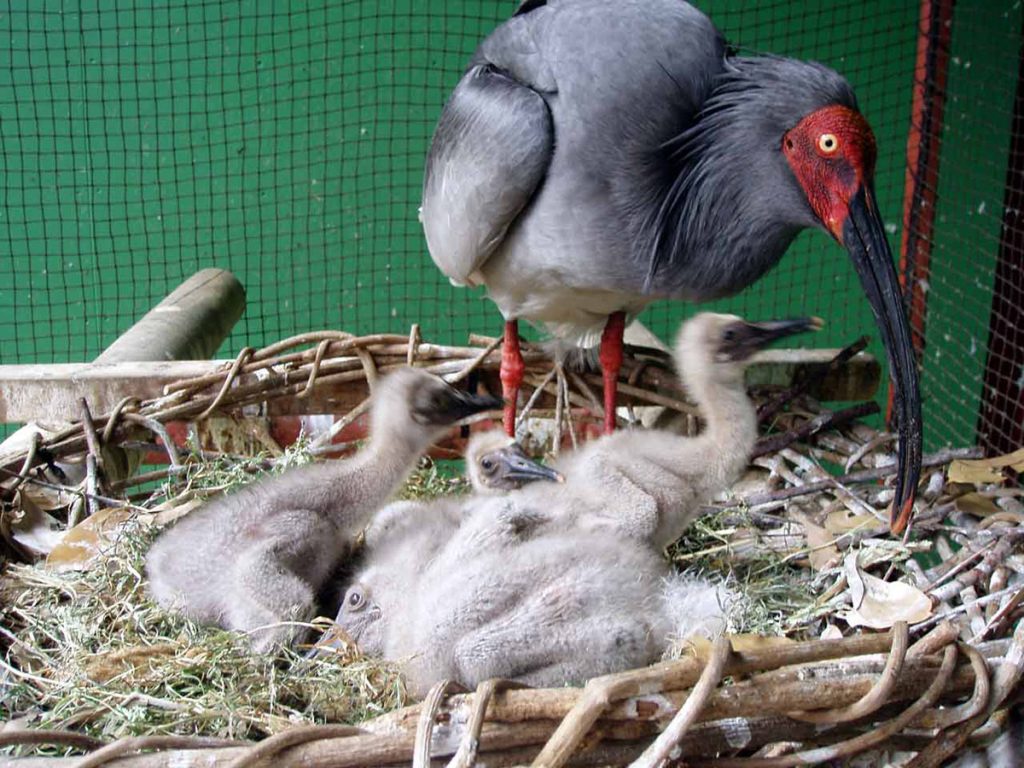
A rare photo of No 50 as a chick, around 7–14 days old, still covered in soft, fluffy down. (Photo courtesy of veterinarian Yoshinori Kaneko)
このページを 日本語 で読む
It has been 17 years since the crested ibis was reintroduced into the wild on Sado Island following its extinction in nature in 1981. This spring of 2025, an 18-year-old male formed a pair with a young, three-year-old female. Although they did not produce any chicks this season, we take a closer look at the life and journey of Crested Ibis No 50.
Tracking No 50
Thanks to a special breeding program, crested ibis were born again on Sado Island in 1999. Then, 17 years ago in 2008, as part of the reintroduction program, the first birds were released into the wild. Of the many birds I encounter on my daily photo walks, one in particular has stood out to me: No 50. He is now an 18-year-old male.
One fascinating part of ibis monitoring is that every released bird wears a numbered leg band, allowing researchers to track individuals over time. These bands, fitted before release, make it possible to monitor survival, habitats, pairings, and even family relationships.
When reviewing my photos, I noticed No 50 appearing in many of my best shots. Since the start of 2025, he's also become a regular presence in the area near my home.

The Third of Four Brothers
Veterinarian Yoshinori Kaneko has spent 32 years working on the crested ibis reintroduction project at the Sado Japanese Crested Ibis Conservation Center. Even for him, No 50 holds a special place.
Born in 2007, No 50 is the third of four brothers from a rare clutch laid by Shinshin, the offspring of Yuyuu and Yangyang, a pair gifted to Japan from China to aid in the species' revival.
"Most ibis nests produce no more than three chicks," Kaneko recalls. "But this was the first time we had a full clutch of four hatchlings at the center, so I remember them well." Only three such four-chick clutches have ever occurred there. Kaneko graciously shared a rare photo of No 50's family for this essay.

Crested ibises lay their eggs one day apart, meaning there can be up to a week between the first and fourth hatchings. A newborn weighs about 50 grams, but within a week, the older siblings may reach 150 grams. This size difference can be fatal for the youngest, who are often crushed beneath older siblings or outcompeted for food. Some wander the nest in search of nourishment, fall out, and don't survive.

No Chicks This Season
No 50 was released into the wild in November 2010. Of the four brothers born that year, he is now the only one still alive. At 18 years old, he is the second-oldest surviving crested ibis among those released. (The oldest is a 19-year-old male born in 2006.)
Crested ibises can live for over 20 years in captivity, but in the wild, survival rates decline sharply after 10 years due to harsher conditions. Despite these odds, No 50 — now paired with a female 15 years younger than himself — spent this season busily gathering twigs and building a nest. Still, no chicks were born.
Male ibises typically remain fertile until around age 20, while females usually stop breeding by 18. No 50 is likely approaching the end of his reproductive years. Yet his continued participation in breeding, 15 years after his release, is a testament to his remarkable vitality.
I plan to keep following his journey.


Click here to read more Sado Wildlife in Focus photo essays by photojournalist Fumie Oyama.
This report was first published on Japan 2 Earth, a JAPAN Forward website featuring Japan's SDGs initiatives. It is the 17th 22nd in the series, Sado Wildlife in Focus by photojournalist Fumie Oyama.
RELATED:
- First Crested Ibis Nest Confirmed as Spring Arrives in Full Bloom
- Newly Fledged Crested Ibis Chicks Take Flight!
- Ishikawa Governor Shares His Statement on Crested Ibis as a Symbol of Recovery
Author: Fumie Oyama

Fumie Oyama is a two-time winner of the Japan Newspaper Publishers & Editors Association Award as a photographer for The Sankei Shimbun. After covering the reintroduction of the crested ibis to the wild for 11 years, Oyama left the company in 2020 to move to Sado Island. There, he continues to photograph the ibis and other wildlife while engaging in farming. He currently promotes the charms of Sado Island as a photojournalist. Follow Fumie Oyama on Instagram.
このページを 日本語 で読む








